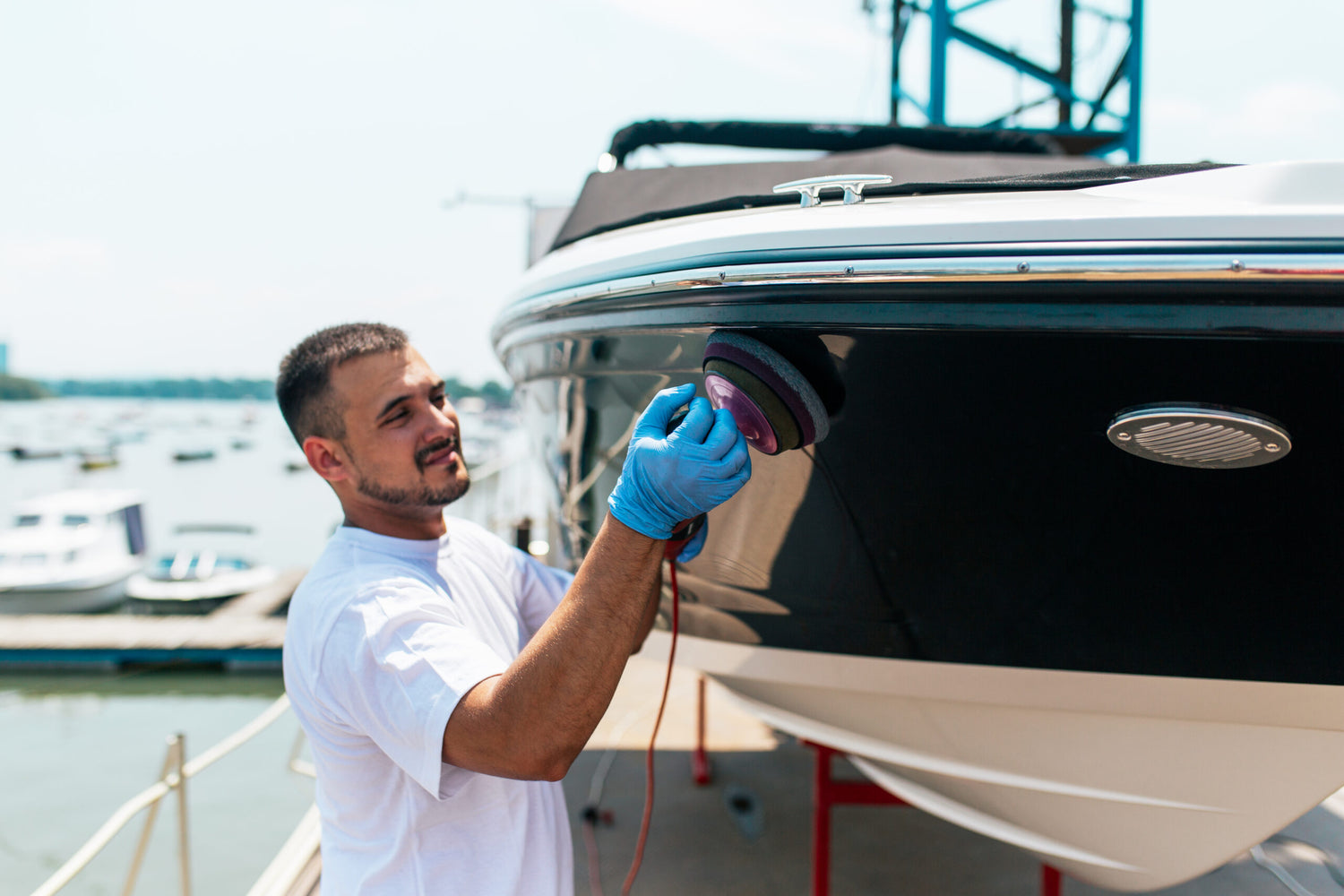
Marine Detailing
Boat detailing is a meticulous process designed to clean, restore, and protect the interior and exterior surfaces of a boat. Boats are constantly exposed to harsh elements such as saltwater, UV rays, algae, and other environmental contaminants, making regular detailing essential for maintaining their appearance and longevity.
Below is a comprehensive step-by-step guide to detailing a boat:
1. Pre-Inspection and Preparation
- Inspection: Conduct a thorough examination of the boat to assess its condition, including oxidation, scratches, and algae buildup.
- Preparation: Remove any personal belongings and accessories from the boat.
- Protective Measures: Tape off and cover sensitive areas such as electronics, vents, and unpainted metal parts to prevent damage during the detailing process.
2. Exterior Cleaning (Hull and Deck)
a) Rinsing
- Rinse the entire boat with freshwater to remove loose dirt, salt, and grime.
- Use a high-pressure hose for stubborn areas, but avoid applying excessive pressure to delicate surfaces.
b) Hull Cleaning
- Algae and Stain Removal: Apply a marine-grade hull cleaner to dissolve algae, barnacles, and mineral stains. Use a soft-bristle brush for scrubbing.
- Chemical Spot Treatment: Use specialized products for rust, waterline stains, and other discolorations.
c) Washing
- Wash the entire exterior with a marine-safe soap and a soft wash mitt.
- Start from the top (roof or flybridge) and work downward to prevent streaking.
- Pay special attention to non-skid surfaces, which require thorough scrubbing to remove grime.
d) Rinsing and Drying
- Rinse off all cleaning products thoroughly.
- Use chamois cloths, microfiber towels, or air dryers to dry the boat completely.
3. Paint and Gel Coat Restoration
a) Surface Assessment
- Check for oxidation, dullness, and light scratches on the gel coat or painted surfaces.
b) Polishing (If Needed)
- Apply a marine-grade polish using an orbital buffer to remove oxidation and restore the gel coat's shine.
- Work in small sections, using overlapping circular motions.
c) Waxing or Sealing
- Apply a marine wax or paint sealant to protect the exterior from UV rays, salt, and oxidation.
- Buff the wax to a high shine for a protective, glossy finish.
4. Metal and Hardware Cleaning
- Metal Polishing: Use a metal polish to clean and protect stainless steel, chrome, and aluminum fittings.
- Corrosion Removal: Treat areas showing signs of corrosion to prevent further damage.
5. Interior Detailing
a) Vacuuming and Dusting
- Thoroughly vacuum all seating areas, carpets, and storage compartments to remove dust, sand, and debris.
b) Upholstery Cleaning
- Fabric Upholstery: Shampoo and steam clean to remove stains and odors.
- Vinyl and Leather: Clean with marine-safe cleaners and condition the material to prevent cracking.
c) Hard Surface Cleaning
- Clean and disinfect countertops, storage compartments, and dashboards.
- Use non-abrasive cleaners to avoid damaging delicate materials.
d) Floor and Carpet Cleaning
- Use marine carpet shampoo and extraction equipment to deep clean carpets.
- For non-skid surfaces and rubberized flooring, scrub with a brush and mild detergent.
e) Glass and Window Cleaning
- Clean all windows, hatches, and mirrors using a streak-free marine-safe glass cleaner.
6. Cabin Detailing (If Applicable)
- Galley and Appliances: Clean countertops, sinks, and appliances.
- Restroom (Head): Sanitize sinks, toilets, and shower areas.
- Odor Elimination: Use marine-grade air fresheners or ozone treatments to neutralize odors.
7. Engine Bay Cleaning (Optional but Recommended)
- Degreasing: Spray a marine-safe degreaser to dissolve grease and grime.
- Brushing and Rinsing: Scrub surfaces gently and rinse with freshwater.
- Drying and Protection: Use compressed air to dry the engine bay and apply protective sprays to metal components.
8. Electrical Components and Gauges
- Clean dashboards, gauges, and switches with an electronics-safe cleaner.
- Avoid excessive moisture to prevent damage.
9. Bilge Cleaning (If Needed)
- Remove water, sludge, and debris from the bilge.
- Use a bilge cleaner to dissolve grease and odor-causing residues.
- Rinse and dry thoroughly.
10. Final Inspection and Touch-Ups
- Conduct a thorough inspection to ensure all areas are clean and polished.
- Address any missed spots or imperfections.
- Apply finishing touches such as vinyl protectants and additional wax if needed.
11. Optional Add-Ons
- Ceramic Coating: Provides long-lasting protection against UV rays, salt, and contaminants.
- Teak Wood Restoration: Sanding, cleaning, and applying protective oil to teak surfaces.
- Graphics Restoration: Repair and touch-up of faded or peeling vinyl graphics.
Maintenance Tips
- Rinse the boat with freshwater after each use to remove salt and contaminants.
- Reapply wax or sealant every 6-12 months for continued protection.
- Schedule a full detailing service at least once or twice a year for optimal boat care.
By following this comprehensive detailing process, boat owners can protect their investment, maintain the boat's aesthetic appeal, and extend its lifespan even in challenging marine environments.
